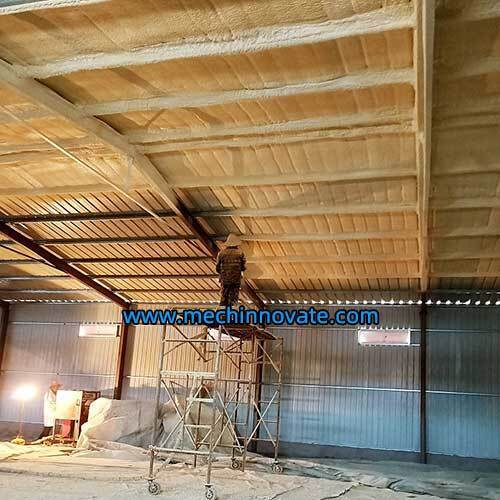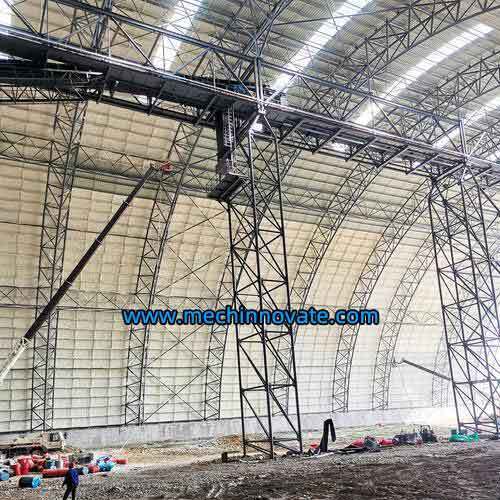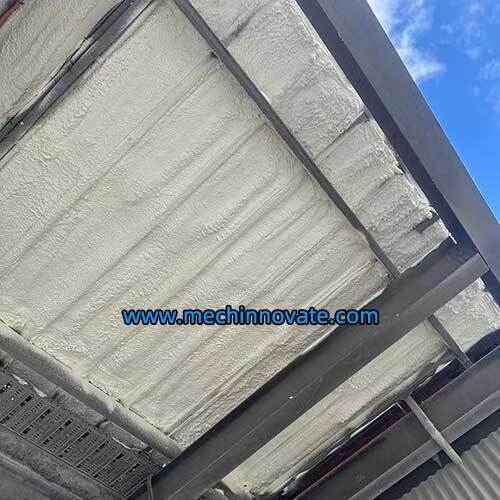Steel Structure Warehouse Roof Foaming System Reviews & Price Comparisons
- 2025-06-21
- View 2
Steel Structure Warehouse Roof Foam: Real Costs and Performance Compared

Imagine walking into your steel warehouse on a scorching summer day, only to find the temperature surprisingly comfortable. No rattling fans struggling to cool the space, no condensation dripping from the ceiling, just consistent comfort that protects both your inventory and your energy budget. This isn't fantasy - it's what properly applied roof foam insulation delivers.
After helping dozens of warehouse owners transform their spaces, I've seen firsthand how the right foam system can slice 20-50% off heating and cooling costs. But with so many options flooding the market, how do you choose without wasting thousands on underperforming equipment? Let's explore what actually works in real warehouse settings.

Why Your Steel Roof Needs Specialized Foam Attention
Steel warehouse roofs present unique challenges that standard insulation solutions often fail to address:
The thermal bridge trap: Steel conducts heat like crazy, creating invisible paths for temperature transfer
Condensation nightmares: Temperature differentials create moisture that invites rust
Expansion and contraction: Metal roofs move with temperature changes requiring flexible seals
Massive surface areas: Covering thousands of square feet requires specialized application approaches
Closed-cell polyurethane foam creates a seamless barrier that tackles all these issues in one application. When Jason at Midwest Tool Storage saw 30% humidity reduction in his inventory area after foaming his 15,000 sq ft roof, his moisture-related product damage claims disappeared.
Breaking Down Roof Foam System Categories
Not all spray systems are created equal. Here's how warehouse-size applications typically break down:
Entry-Level Portable Units ($7,000-$15,000)
Best for: Roofs under 5,000 sq ft or businesses doing multiple small projects
Performance Notes: These compact rigs like the workhorse Q30 model deliver surprisingly professional results. But they need more frequent refills on large roofs.
Mid-Range Hydraulic Systems ($25,000-$50,000)
Best for: Roofs between 5,000-20,000 sq ft or growing operations
Performance Notes: Systems like the T40 sprayer maintain consistent pressure through multi-hour application sessions. The sweet spot for warehouses adding insulation incrementally.
Industrial Continuous Spray Systems ($50,000-$100,000+)
Best for: Massive facilities exceeding 20,000 sq ft or commercial applicators
Performance Notes: Machines like the H5600 are beasts designed for uninterrupted spraying. For perspective, they can cover a football field-sized roof in just 2 days. Many users appreciate the advanced output controls that prevent over-application.

The Real Cost Breakdown Beyond the Sticker Price
That equipment number is just the starting point. Wise warehouse managers budget for:
Cost Factor
Entry-Level
Mid-Range
Industrial
Equipment Purchase | $7k-$15k | $25k-$50k | $50k-$100k+ |
Annual Chemical Cost (per 10k sq ft) | $3,500 | $2,800 | $2,300 |
Prep & Access Equipment | $1,000-$3,000 | $2,000-$4,000 | $5,000-$8,000 |
Professional Training | $800 | $1,200 | $1,500 |
Energy Savings Year 1 | $3.75/sq ft | $4.10/sq ft | $4.25/sq ft |
Notice how energy savings climb with equipment grade? Higher-end systems typically deliver more consistent foam application and less waste. For unusual roof designs, custom-configured solutions often prove more cost-effective long-term.
Performance Face-Off: What Warehouse Owners Actually Experience
Reviews from actual users reveal the practical differences:
Application Speed
"Our T40 system covers about 1,000 sq ft per hour with two operators. That's twice what we managed with our previous portable unit. Made completing our 12,000 sq ft roof manageable in a week." - Marcos G., Florida
Long-Term Durability
"Five years in, our foam insulation still looks and performs like new. The contractor used industrial-grade equipment that applied perfectly even layers." - Sandra T., Oregon
System Reliability
"Learning curve was steep, but the Q1600 system has sprayed flawlessly through three projects without a single service call. That reliability matters on tight deadlines." - Warehouse Manager, Texas Distribution Center

Avoiding Sprayer System Pitfalls
Based on dozens of installations, here's how to dodge common mistakes:
Weather missteps: Foaming in high humidity causes bubbling. Always check dew point forecasts
Inconsistent passes: Spraying too fast creates thin spots that compromise insulation value
Surface prep shortcuts: Cleaning might seem tedious but it prevents adhesion failures
Cooling neglect: Steel roof temperatures can soar. Start spraying early before metal heats up
The best insurance? Work with a supplier that offers hands-on application guidance specific to steel structures.
The Energy Payback Timeline
When Sarah insulated her Ohio parts warehouse's 8,000 sq ft roof, the numbers spoke volumes:
Equipment cost: $42,000
Annual savings: $11,600 (heating/cooling)
ROI period: 3.6 years
Added benefit: Reduced fan maintenance ($2,100 annually)
Smaller operations often prefer budget-smart approaches that balance upfront costs with energy returns.
Finding Your Perfect Match: Decision Factors
Choosing between systems? Consider these crucial elements:
1. Roof Surface Area
More than 20,000 sq ft? Industrial continuous spray systems become essential.
2. Future Applications
Planning to insulate multiple facilities? Higher-grade equipment pays dividends.
3. Application Frequency
Regular touch-ups? Choose systems with easy maintenance access.
4. Temperature Extremes
Frigid climates? Prioritize systems with material pre-heaters.

Professional Application Considerations
Many warehouse operators wisely opt for professional installation:
Installation timeline: Crews typically cover 3,000-5,000 sq ft daily
Labor costs: $1.50-$2.75 per sq ft (based on complexity)
Warranty value: Pro installation often includes 10-15 year system warranties
For challenging curved roofs like those on aircraft hangars, specialized spraying techniques matter. High-yield application methods ensure even coverage on difficult surfaces.
The Long View: Beyond Initial Savings
The thermal benefits only tell part of the story:
Structural reinforcement: Properly applied foam can increase roof rigidity up to 30%
Sound dampening: Warehouse noise levels drop noticeably - no more echoing metal
Moisture prevention: By eliminating condensation, roof corrosion slows dramatically
Light reflection: Light-colored foam coatings increase interior brightness
Looking at real-world spray projects reveals these additional advantages that often surprise facility managers.
Your Next Smart Steps
Choosing the right foam system for your steel warehouse roof doesn't need to feel overwhelming:
Measure precisely: Get exact square footage including tricky angles
Consider access needs: How will equipment reach your roof safely?
Request samples: Most suppliers offer material samples and test patches
Review warranties: Protection periods vary significantly
Check references: Ask to see completed projects similar to yours
The perfect solution balances your budget with performance needs. When in doubt, consulting with experienced system specialists helps clarify options without sales pressure.
Transforming that baking-hot or freezing steel roof into a comfortable, energy-efficient barrier? That's not just business—it's smart business. The right equipment choice makes it achievable without breaking the bank.



